
Divisions
- Communications Unit
-
Ministerial and Executive Services
- The Secretary
- Cabinet and Executive Council Office
- Executive Council Secretariat
- Register of Lobbyists
- Right to information
- Tasmanian Government Boards
- Caretaker conventions
- Public Submissions Policy
- Parliamentary (Disclosure of Interests) Amendment Bill 2017
- Our Legislative Responsibilities
- State Protocol Office
- Guidelines and policies
Contact Details
By phone
Find the number of a specific division or office to contact them directly or call Service Tasmania on 1300 135 513.
Our staff
Use the Tasmanian Government Directory to find staff contact details
Social media
Follow our social media accounts to keep up to date with specific programs and initiatives.
State symbols
Find out more about the Tasmanian state symbols:
Coat of arms
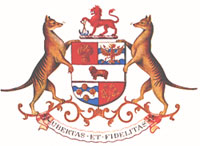
The Tasmanian Coat of Arms, approved by King George V in 1917 and proclaimed in 1919, reflects the State’s British heritage and its industries.
The lion above the shield has its origins in British heraldry. Its forepaw rests on a pick and shovel to represent the Tasmanian mining industry.
Within the shield, a sheaf of wheat represents agriculture, a heraldic thunderbolt depicts hydro-electricity and a ram illustrates the wool industry. Apples and hops are also depicted.
The Latin motto “Ubertas et Fidelitas” translates as “Fruitfulness and Faithfulness”.
A pair of Tasmanian tigers, or thylacines, form the supporters to the shield. The thylacine, a carnivorous marsupial, was common in Tasmania in the nineteenth century, but is now considered extinct.
Floral emblem

The Tasmanian blue gum, Eucalyptus globulus (Labill.), was collected from the south-east coast of Tasmania in 1792-93 by the French naturalist J. J. H. de Labillardiere and was described and illustrated by him in 1799. Labillardiere was a member of an expedition, which, under the command of Bruny d’Entrecasteaux, sailed to the Southern Hemisphere in search of the missing explorer J. F. G. de La Perouse.
In favourable situations the Tasmanian blue gum grows into a tree up to about 60 metres high. The trunk is smooth and greyish-white in the upper part where the bark peels in long reddish-brown ribbons; at the base the bark is often persistent, rough and deeply furrowed.
The name “blue gum” refers to the appearance of the juvenile leaves, which are borne in opposite pairs on square stems.
Flowering occurs fairly regularly each year in early summer. Bees collect both pollen and nectar and a characteristic amber-coloured honey is produced. The flowers are also an important food source for native birds, including the critically endangered Swift Parrot (Lathamus discolor). The large woody fruit is almost flat-topped and opens by four or five valves through which numerous small seeds are shed.
Faunal emblem
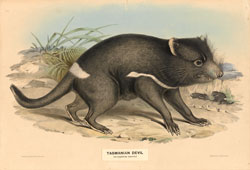
Copyright: Tasmanian Devil (Sarcophilus harrisii) John Gould 1846 Hand coloured lithograph, Collection: Tasmanian Museum and Art Gallery
The Tasmanian devil, Sarcophilus harrisii (named by Pierre Boitard in 1841) is the world’s largest remaining carnivorous marsupial (since the extinction of the thylacine). It is found in the wild only in Tasmania where it is widespread. Although once common, it is now a threatened species.
The name for the devil in palawa kani, the modern language of Tasmanian Aboriginal people, is "purinina". Its scientific name, Sarcophilus, means "flesh-loving" and "harrisii" comes from George Harris, the surveyor and naturalist who described the species in 1808. It was given the name ‘devil’ by early European settlers who were frightened by its unfamiliar night-time calls.
Since the mid-1990s, devils have suffered a major threat due to an unusual transmissible cancer known as Devil Facial Tumour Disease (DFTD). This lethal disease is spread primarily by direct contact between devils. Signs of DFTD were first noticed in 1996 in Tasmania’s North-East. The disease has since spread across most of the state, causing a drastic decline in devil numbers. As a result of the disease epidemic, the Tasmanian devil was classified as endangered in 2008.
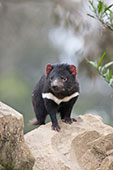
Copyright: Tasmanian Government
A national conservation program, the Save the Tasmanian Devil Program, was established in 2003. By 2012, an insurance population of over 600 captive devils had been established to guard against the species’ extinction. Conservation efforts are now focussed on the recovery of the devil in the wild, with the reintroduction of devils into isolated, disease-free and specially managed landscapes.
Since the loss of the thylacine, the devil has assumed a role as Tasmania’s top predator, a position shared with eagles. Devils are fundamental to the stability of the Tasmanian ecology. They play a vital role in competing with introduced predators such as feral cats, helping to balance the numbers and health of prey species, and removing injured, diseased and dead animals from the environment.
Mineral emblem
Crocoite (lead chromate – PbCrO4) 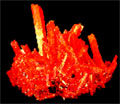 is composed of lead, chromium and oxygen. It has a minor value as an ore of lead or chromium but is highly valued in its natural state for its beauty, orange red colour and shape of its needle-like crystals. The metal chromium was first discovered in crocoite in 1797.
is composed of lead, chromium and oxygen. It has a minor value as an ore of lead or chromium but is highly valued in its natural state for its beauty, orange red colour and shape of its needle-like crystals. The metal chromium was first discovered in crocoite in 1797.
Crocoite was first discovered near Beresov, in the Ural Mountains in Russia, in 1763. It has since been found in a number of other locations, but it is in Tasmania that the largest, best quality and most abundant specimens are found.
Crocoite was first observed in Tasmania at the Heazlewood silver-lead mine in 1895 and discovered at Whyte River, Magnet and at Dundas shortly thereafter. Crocoite is now rarely seen from the Heazlewood and Whyte River areas. At Magnet, fine prismatic crystals five centimetres and longer occur in the gossan, some associated with the yellow ‘chrome’ cerussite.
The best and most plentiful specimens of crocoite are found in the Dundas area, some ten kilometres from Zeehan. There, particularly in the Adelaide and Red Lead mines, brilliant crystals, up to 10 centimetres or longer commonly occur. They grow freely on the walls of cavities. Early in the twentieth century the Adelaide mine provided large quantities of crocoite for the Zeehan smelter where it was used as a flux.
Crocoite crystals have been mined at Dundas for over a century. The field still supplies most of the world’s demand for this exquisite mineral.
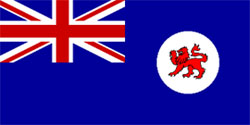
A proclamation which appeared in the Hobart Town Gazette on 25 September 1876, and accompanied by illustrations, officially proclaimed three flags for the colony of Tasmania. These flags were the Governor’s flag, the flag for Government vessels and the flag for merchant vessels.
For reasons unknown the proclamation was revoked soon after. However, the flag for Government vessels, the Blue Ensign with lion passant on a white shield or badge in the fly of the flag, was subsequently adopted for general State Government use, but was not officially gazetted until 3 December 1975.
There is no official record of the reason for using the lion. Lions have featured prominently in European heraldry for centuries, and it has been supposed that the lion symbolises the colony’s loyalty to Great Britain.
General description
A Blue ensign with the proportions two by one consisting of a blue flag with the Union Jack occupying the upper quarter next to the staff with a lion passant red on a white shield in the fly.
The white shield
A circular white ground with a diameter equal to three-sevenths of the breadth of the flag and positioned with its centre one-quarter of the length of the flag from the edge of the fly and on the line between the upper and lower quarters.
The lion
A red lion in the passant position fimbriated in black inside the white shield facing towards the staff.
See also:
Further information:
Protocol Office
Phone: 03 6270 5667
Email: protocol@dpac.tas.gov.au
Disclaimer:
Approval of the Secretary, Department of Premier and Cabinet must be sought before the coat of arms or any emblems are reproduced. Reproduction is usually granted for educational purposes only.
Please email protocol@dpac.tas.gov.au to seek permission.
